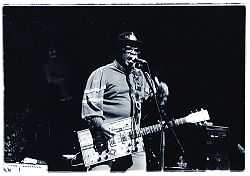Bo Diddley beat

The Bo Diddley Beat is a kind of syncopated five-accent clave rhythm. The Bo Diddley beat is named after Bo Diddley, who introduced and popularised the beat with his self-titled debut single. Although Bo Diddley was a rhythm and blues musician essentially, the beat is widely used in rock and roll and pop music.[2][3][4]
History and composition
The "Bo Diddley Beat" (1955) is perhaps the first true fusion of 3-2 clave and R&B/rock 'n' roll.
The Bo Diddley beat is essentially a 3-2 clave rhythm, one of the most common bell patterns found in Afro-Cuban music, and its origin goes back to the sub-Saharan African music traditions.[5] But there is no documentation of a direct Cuban connection to Bo Diddley's adaptation of the clave rhythm. Bo Diddley has given different accounts regarding how he began to use this rhythm.
Sublette asserts: "In the context of the time, and especially those maracas [heard on the record], 'Bo Diddley' has to be understood as a Latin-tinged record. A rejected cut recorded at the same session was titled only 'Rhumba' on the track sheets."[6] Somewhat resembling the Shave and a Haircut rhythm, Diddley came across it while trying to play Gene Autry's version of "Jingle, Jangle, Jingle".[7]
The Bo Diddley beat is similar to "hambone", a style used by street performers who play out the beat by slapping and patting their arms, legs, chest, and cheeks while chanting rhymes.[8]
In its simplest form, the Bo Diddley beat can be counted out as either a one-bar, or a two-bar phrase. Here is the count as a one-bar phrase: One e and ah, two e and ah, three e and ah, four e and ah. The bolded counts are the clave rhythm.
Songs using the Bo Diddley Beat
 |
Bo Diddley" (1955)
Bo Diddley's "Bo Diddley" (1955), his debut single which introduced the Bo Diddley beat. |
| Problems playing this file? See media help. | |
Three years before Bo's "Bo Diddley" (1955), a song similar syncopation "Hambone", was cut by Red Saunders' Orchestra with The Hambone Kids. In 1944, "Rum and Coca Cola", containing the Bo Diddley beat, was recorded by The Andrews Sisters and later Buddy Holly's "Not Fade Away" (1957) and Them's "Mystic Eyes" (1965) used the beat.[1] This rhythm occurs in 13 rhythm and blues recordings made in the years 1944–55, including two by Johnny Otis from 1948.[9]
Other well-known songs employing the Bo Diddley beat include "Willie and the Hand Jive" by Johnny Otis (1958), "(Marie's the Name) His Latest Flame" (1961) by Elvis Presley, "When the Lovelight Starts Shining Through His Eyes" by The Supremes (1963), "I Want Candy" by The Strangeloves (1965), "Please Go Home" by The Rolling Stones (1966), "Magic Bus" (1968) by The Who, "1969" (1969) by The Stooges, "She Has Funny Cars" (1969) by Jefferson Airplane, Suzanne (1968/9) by Fairport Convention, "Panic in Detroit" (1973) by David Bowie, "Shame, Shame, Shame" by Shirley & Company (1974), "She's the One" (1975) by Bruce Springsteen, "American Girl" (1977) by Tom Petty and the Heartbreakers, "Rudie Can't Fail" (1979) by The Clash, "I Want Candy" (cover) by Bow Wow Wow (1982), "Mr. Brownstone" (1987) by Guns N' Roses, "Faith" (1987) by George Michael, "Desire" (1988) by U2, "Movin' on Up" (1991) by Primal Scream, "Woodcutter's Son" (1995) by Paul Weller, "Screwdriver" (1999) by The White Stripes, and "The Big 5-0" (2004) by Stan Ridgway.[10][11] "Party at the Leper Colony" (2003) by "Weird Al" Yankovic is a comedy song featuring the Bo Diddley beat.
More subtle uses of the Diddley beat include "Hateful" (1979) by The Clash and "How Soon Is Now?" (1985) by The Smiths.[10]
References
- ↑ 1.0 1.1 Hicks, Michaël (2000). Sixties Rock, p.36. ISBN 978-0-252-06915-4.
- ↑ Brown, Jonathan (June 3, 2008). "Bo Diddley, guitarist who inspired the Beatles and the Stones, dies aged 79". The Independent. Retrieved April 26, 2012.
- ↑ "Bo Diddley". The Rock and Roll Hall of Fame and Museum. Retrieved October 27, 2008.
- ↑ "Bo Diddley". Rolling Stone. 2001. Retrieved April 26, 2012.
- ↑ Peñalosa, David (2010: 244). The Clave Matrix; Afro-Cuban Rhythm: Its Principles and African Origins. Redway, CA: Bembe Inc. ISBN 1-886502-80-3.
- ↑ Sublette, Ned (2007: 83). "The Kingsmen and the Cha-cha-chá." Ed. Eric Weisbard. Listen Again: A Momentary History of Pop Music. Duke University Press. ISBN 0822340410
- ↑ "Blues Reflections". Afropop.org. April 3, 1970. Retrieved February 20, 2011.
- ↑ Roscetti, Ed (2008). Stuff! Good Drummers Should Know, p. 16. Hal Leonard Corporation. ISBN 1-4234-2848-X.
- ↑ Tamlyn, Garry Neville (March 1998). The Big Beat: Origins and Development of Snare Backbeat and other Accompanimental Rhythms in Rock'n'Roll (PDF) (Thesis). University of Liverpool. p. 284. Retrieved 4 August 2014 – via Philip Tagg.
- ↑ 10.0 10.1 Harris, John (2010). Hail! Hail! Rock'n'Roll: The Ultimate Guide to the Music, the Myths and the Madness. Hachette. p. 149. ISBN 0748114866. Retrieved July 5, 2012.
- ↑ "Bo Diddley Beat – Television Tropes & Idioms". Tvtropes.org. Retrieved February 6, 2013.